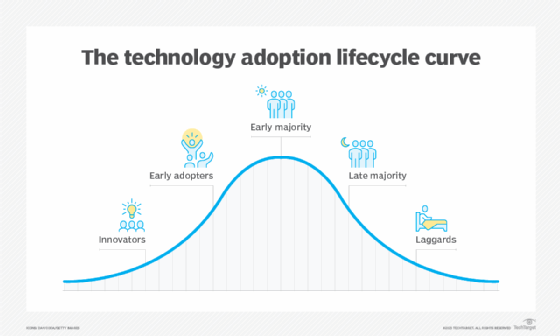technology adoption lifecycle
What is the technology adoption lifecycle?
The technology adoption lifecycle describes how different customers accept and adopt new technology, with early adopters enthusiastically embracing new products and services, and later adopters taking longer to make a purchase decision. By dividing people into groups, the model helps businesses target their marketing and sales campaigns.
There is seldom unanimous consensus among potential customers on the value of a new product -- some early adopters will want it right away; others will wait to decide on a purchase and still others will wait even longer to determine if the product is a wise investment. A bell curve is the best way to visualize the technology adoption lifecycle.
The model divides a populace into different adopter groups according to their demographic and psychological characteristics. For example, there will always be a small group of tech experts and enthusiasts who are eager to embrace new products or concepts. Conversely, there are those who are skeptical and need convincing, at least initially.
Business leaders with an understanding of the technology adoption lifecycle can tailor their marketing efforts to the needs of specific groups and gain a competitive advantage. The lifecycle model also underscores the risks associated with trying to reach the more resistant groups too quickly.
This article is part of
What is digital transformation? Everything you need to know
Why is the technology adoption lifecycle important?
Tech visionaries and developers know that to achieve long-term success, they can't just cater to a small group of fellow tech enthusiasts. Instead, they must expand a new product or tech trend's reach to others who might not initially be convinced of the value of what they're selling.
The technology adoption lifecycle delineates five stages of adoption, using demographic and psychological characteristics to identify different customer adoption levels. Early stage adopters are potential customers who would be the easiest to convert into adopters. Late stage adopters are those who would be the most difficult to reach.
The model's psychographic profiles are used to group people according to their interests, social status and other characteristics that might influence their purchasing decisions. Businesses use this form of customer profiling to shape the marketing campaigns they develop to reach each of the profiled groups. Acceptance of a new product by the various groups determines how effective those outreach efforts are.
Prominent examples in recent history show how the technology adoption lifecycle model works. For example, the disparity in people's eagerness to adopt Apple's iPhone was on full display when early adopters rushed to embrace it, while the public at large took longer to incorporate it into their daily lives. Also, some people embraced social media sites much quicker than others, including newer and lesser-known ones.
What are the 5 stages of the technology adoption lifecycle?
The consensus of marketing experts is that the public can be separated into five groups according to how eager they are to embrace new tech products and services and how soon they will become customers. Different adaptations of this lifecycle model call the groups by different names, but the following descriptions are true regardless of label:
- Innovators. This first group is made up of innovators and developers who bring forward new innovative products. They must do the hard work of convincing the other groups, especially the last three, that the functionality of their product is useful and potential customers should become adopters.
- Early adopters. Early adopters make up a slice of the population that's somewhat larger than the innovator group. Early adopters are enthusiastic about technology trends. They're often young and financially stable enough to afford expensive new products.
- Early majority. Also known as pragmatists, this group is typically the largest. The early majority are risk-averse and must be convinced by the first two groups that the product or service will fulfill their essential needs.
- Late majority. The late majority will wait until average consumers in their communities have purchased and verified the practicality of a product before purchasing.
- Laggards. This group includes those with very little interest in technology as well as those who end up not purchasing a product at all. This segment of the population skews older and is the most skeptical of technological change in society.
The first two groups are known as the early market segment, while the other three are the mainstream market. All five groups can be visualized using a technology adoption curve where one side of the curve shows where the lifecycle begins -- with innovators -- and the other side shows where it ends -- with laggards.

The technology adoption lifecycle chasm
Geoffrey Moore depicts an adaptation of the tech product adoption lifecycle model in his book Crossing the Chasm, which was first published in 1991. He describes a disconnect or chasm between the early market and mainstream market, because potential customers in the mainstream market aren't receptive to recommendations from the early adopter group. Marketers must find a way to overcome this gap, or their product won't succeed with mainstream customers and gain market share.
To successfully cross that chasm, marketers must focus on selling their new technology to the most receptive segment of their early majority market. Once a new tech product or service has a small group of early majority adopters, those people can help convince other potential early majority adopters that the new technology will work for them too. Word of mouth and user experiences are crucial for new technology to gain traction with the mainstream market.
History and origins of the technology adoption lifecycle
In the late 1950s, George Beal and Joe Bohlen came up with what they called the diffusion process, which examined how farmers accepted new agricultural technology being used to expedite mass production. Similar to the early and late majorities of the technology adoption lifecycle model, Beal and Bohlen found that farmers wanted to learn about products from media advertising and word-of-mouth experiences before buying.
Everett Rogers developed the original technology adoption lifecycle model in his 1962 book Diffusion of Innovations. He described the adoption process as a bell curve and defined the five adopter categories representing different parts of the curve. Rogers initially applied his model to agriculture in the Midwest, also looking at farmers' attitudes toward new technology.
As AI becomes more ubiquitous, the speed of generative AI adoption by enterprises exemplifies the enthusiasm of early adopters. In fact, more than half of IT and business decision-makers plan to adopt generative AI in the near term.







